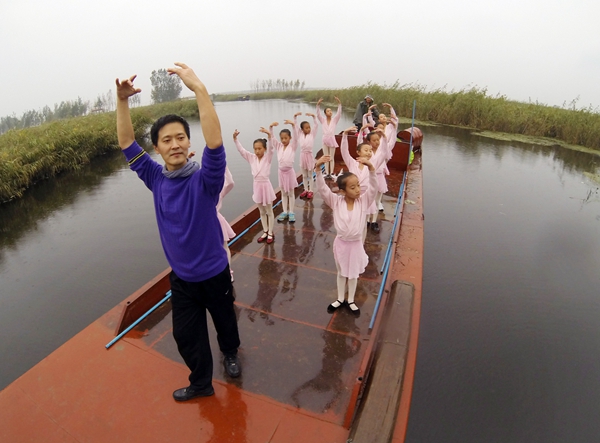 |
|
Teacher Guan Yu, of the Beijing Dance Academy, leads girls in ballet practice during an outdoor class in the Baiyangdian wetland in Hebei province. [GAO TIAN/CHINA DAILY] |
Professional teachers from Beijing have been spending their weekend leisure time teaching deprived rural youngsters the basics of classical dance as a way of improving their self-confidence, as Zhao Xu reports from Duancun, Hebei province.
I n August last year, Guan Yu, a ballet teacher from the Beijing Dance Academy, spent a few days in Duancun, a small rural town in the northern province of Hebei. "The day I arrived, at noon, I went to eat at a small restaurant. It was the height of summer. All around me, shirtless men were talking at the tops of their voices and happily washing down skewers of grilled meat with giant glasses of beer," he recalled.As he waited for his food, Guan caught a glimpse of a girl jumping off a bicycle. She was Li Ziyi, a former student who quit his classes when she entered middle school earlier in the year.
"She came into the room. We were surrounded by clouds of cigarette smoke, mingled with the heavy steam coming from the tiny kitchen at back. She called out to me, but her words were drowned by the noise," Guan said. "Slightly taken aback, I stood there, not knowing what to do. That's when she came up and gave me a big hug, as if the rest of the room didn't exist."
Guan has been making weekly trips to Duancun, 100 kilometers from Beijing, since 2012 to provide free ballet classes for local children. "We go there every Sunday and return the same day, spending six hours on the road and about five hours teaching," the 45-year-old said.
One day in late September, in a purpose-built ballet studio in the basement of Duancun School, about 20 girls, most of them about age 9, were doing barre exercises under Guan's direction. They wore pink dance costumes and soft shoes, and each had tucked every lock of hair into a shiny bun on her head. Class had just begun and some latecomers were trying to sneak into the formation, pulling funny faces at their fellow dancers.
The youngest children on the outer fringes constantly sneaked glances at those beside them to make sure that they were making the right moves. All the instructions were given in French, the official language of ballet.
A powerful weapon
Li Feng is the driving force behind the project. "Why do we bother with art when poverty is the top concern?" he prompted, before answering his own question. "It's because in the fight against poverty, few weapons are more powerful than art."
Born in Beijing to high-ranking government officials, Li has led a reasonably privileged life, even during the "cultural revolution" (1966-76) when all the schools were closed. "With no school to attend, I listened to Western classical music and read Renaissance history," said the 60-year-old investor, who returned to Duancun, his ancestral home, late in life and discovered little but despair.
"It's a feeling shared by many people-especially young men and women-in rural China. The only way out seems to be via the college entrance exam. But with the country's educational resources concentrated on the cities, even that way has been effectively blocked for most of them," he said. "Many choose to become migrant workers away from home, where they are bound to encounter discrimination in some form."
Convinced of the power of art to bolster confidence where traditional academic training has failed, Li decided to establish an art education project in 2012. It featured five fields of study: Painting; theater performances; wind and string instruments; choral song; and ballet. Free classes are held every weekend, with teachers coming from schools and groups in Beijing. Li pays all their expenses. To provide badly needed space, he and some friends built the Duancun School, which opened 18 months after the classes started.
"Of all the different types of art, ballet is the most challenging, and the one I most insisted on having," he said. "If you look at the way the girls dance, how they hold their chins up during a high leap, you'll understand my point. Ballet is not just ethereal, it's regal. Even a deep bow at the curtain call has a grand feeling about it. To dance ballet is to cultivate a firm, intense self in one's heart."
